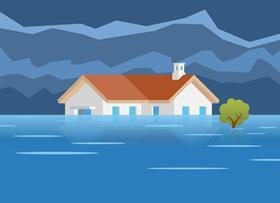Ground floor flood vents can play an important role in mitigating flood damage, for example
The UK should be taking note of key resilience takeaways following Hurricane Ian, which hit US state Florida in September 2022, according to Dan Dick, global head of property solutions within broker Aon’s reinsurance division.
Speaking exclusively to Insurance Times, Dick shared his perspective following the publication of Aon’s February 2023 report entitled Hurricane Ian: Rebuilding for resilience. This investigated the aftermath of the weather event in order to find ways to inform and enhance future risk mitigation strategies.

In the wake of Hurricane Ian, Aon sent a team of engineers, meteorologists and hydrologists to affected areas to evaluate the impact of the storm – this research aimed to help homeowners, governments and insurers make better decisions around creating more resilient and safer buildings.
According to Aon’s 2023 Weather, climate and catastrophe insight report, which was published in January 2023, Hurricane Ian caused an economic loss of more than $95bn (£77.2bn) and an insured loss of up to $55bn (£44.7bn).
The report defined the event as the second costliest natural catastrophe in history from an insurance perspective, surpassed only by 2005’s Hurricane Katrina – also in the US – which resulted in nearly $100bn (£81.3bn) of insured losses on a price inflated basis.
Aon’s assessment within its February report revealed that while outdated construction methods often result in catastrophic damage, Florida’s enhanced building code was successful in protecting homes – he suggested that other countries, including the UK, could adopt similar measures to protect communities.
Florida’s state-wide building code, which was introduced in March 2002, governs the design, construction, erection, alteration, modification, repair and demolition of public and private buildings, structures and facilities.
Run by the Florida Building Commission, the code is updated every three years and can be amended annually.
In addition to standardising design, construction and compliance processes, the code also contains regulations around safety, health, the welfare of building occupants and emergency responders, structural strength, means of egress, stability, sanitation, adequate light and ventilation and energy conservation.
Dick explained that the benefits of a single and clear code for the building of homes and commercial premises in flood and storm prone areas had proved to be a significant weapon in improving resilience – therefore, it could be a lesson learned for the UK.
“As insurers, we need to be having discussions with our clients about mitigation, should the worst occur, before any event - not at a time when they are under distress,” Dick said.
“Homeowners should understand what they need to do before any event, so if it does occur, they already know how they can mitigate the damage and reduce the loss.”
Roof quality
Aon’s February 2023 report highlighted a range of issues for the insurance sector, Dick continued, as well as highlighted ways in which the market could help mitigate the damage caused to homes and commercial buildings during wind and flood events.
He said: “As insurers, we take the lessons learned from events such as this and apply them to prevent or mitigate losses.
“In terms of building codes, Florida has a very developed set of codes - but it is not only the codes [that have an impact], but also the verification and inspection systems which support them.”
Read: Storm Arwen winds sweep up over £80m worth of claims – NFU Mutual
Read: European windstorms caused £3,142m in insurance industry losses – Perils
Explore more news articles here, or read risk management-related content here.
Dick added that Aon’s report had found that preconceived ideas around the resilience and lifespan of asphalt shingle roofs were erroneous and that much depended on the quality of the materials used.
“I was surprised at the differing standards for materials used on roofs across the area affected by Hurricane Ian,” Dick explained.
“[The report] highlighted that you may well hire the more highly rated construction firm to carry out repairs, but some are tied to specific manufacturers and the quality of the materials may not match the standard of the workmanship.”
He noted that an additional lesson that had been learned from last September’s hurricane was that any defects in roofs can have a major impact on the level of damage sustained by a property should high winds strike.
“The message is clear. If there is any problem - structural or otherwise - with a roof, it needs to be repaired or replaced before any poor weather,” he emphasised.
Mitigating flooding
On flood threats, Dick said the benefits of flood vents that had been installed on the ground floor of flood exposed buildings in Florida has been significant.
“The vents allow flood water to access the building, but also [allows] the water to be sucked out as the floods recede,” he explained.
“While it sounds counterintuitive to allow water in, the ability for the water to drain [reduces] the pressure on the building and the walls as the flood reduces.
“Better to be faced with painting a wall than have the pressure of the water cause the walls to collapse.”
Dick noted that “the industry can learn a lot of lessons” from Florida in terms of resilience, “which can be applied in the UK”.
“The issue is that we need to communicate and educate our clients to ensure they are better prepared for when events occur and understand what needs to be done to mitigate any damage should the worse occur,” he continued.












































No comments yet